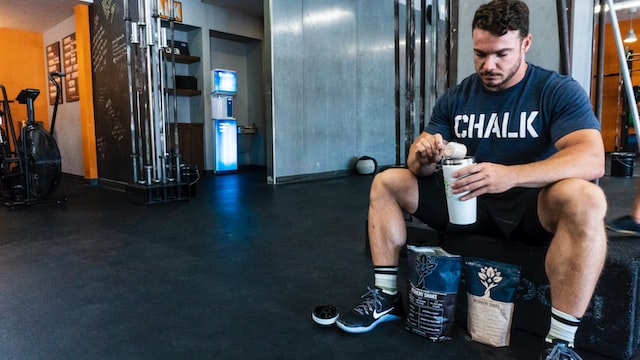When people lose weight, they may also lose muscle. This is known as weight-reduction-induced muscle loss, and it can put you at risk of developing sarcopenia, a condition characterized by low muscle mass and impaired muscle function.
If you take steps to maintain your lean muscle mass while losing excess weight, you will face new hurdles. It can be more difficult to track your progress because the numbers on the scale do not always change, even if your body shape does.

Muscle Gain vs. Fat Loss
According to one study, young women who followed a 12-week combined cardio and strength program lost 10% of their body fat while increasing their muscle mass by nearly 9%. A smaller trial of older women revealed that a 12-week swimming program reduced body fat and increased physical strength.
According to research, beginners respond fast and efficiently to both strength and cardio training. If you’ve previously grown muscle but then lost it, the result is comparable. Your muscles have a sort of “memory” of what it was like to be bigger, that is why re-building that muscle is easy.
If you are a moderate exerciser looking to enhance your fat-muscle ratio, you can reduce body fat while developing your lean body tissue over time. In fact, if you’re new to exercise, you’re more likely to reap the benefits of both fat reduction and muscle building.
If you’re an accomplished exerciser or bodybuilder seeking to acquire a lot of muscle while also reducing a lot of fat, this may be difficult because those goals frequently contradict. Why?
Simply told, muscular development necessitates consuming more calories than you expend. To lose fat, you must consume less calories than you burn. When you’re cutting calories to lose weight, your muscles don’t get the nourishment they need to get bigger.

Techniques for Trading Fat for Muscle
If you want to achieve a healthy mix of fat reduction and muscle gain, here are a few suggestions.
Perform Cardio and Strength Training
Whether you’re a neophyte or an experienced exerciser, the goal is to combine both cardio and strength training into your exercise routine.
Cardio without strength training can reduce muscular mass (shrinking your muscles instead of building them). However, weight training without cardio can jeopardize fat reduction. So, both.
Exercise should be prioritized based on your goals
Even though your workout will contain both aerobic and strength components, you do not need to prioritize both. Focus on cardiovascular endurance if you’re a marathon runner. Concentrate on muscular gain if you’re a bodybuilder.
A balance of the two is the greatest strategy for a beginner or average exerciser to maximize fat reduction while keeping muscular mass. Also, keep in mind that you might drop fat without dropping weight, so your scale may not be an accurate reflection of your success.

Don’t Forget About Your Diet
Although exercise is important, fat reduction occurs mostly in the kitchen. In order to reliably maintain a healthy weight, the USDA suggests eating a diet rich in vegetables, lean proteins, fruit, beans and lentils, whole grains, low-fat or fat-free dairy, and oils (vegetable oils and oils found in nuts and shellfish).
You may also benefit from seeking the advice of a certified nutritionist to assist you in developing an eating plan to match your objectives. In most circumstances, a nutritionist can assist you in creating a meal that allows you to consume foods you enjoy while still getting the nutrition you need to reduce fat while weight training.
Change Your Recovery Times
While overtraining or not allowing your body adequate time to recuperate between sessions may not result in muscle loss, it can have an impact on your muscle’s strength and endurance. It can also increase your chance of injury, making weight reduction exercise more difficult.
Overtraining can affect both new exercisers and athletes. Skip a day or two if you realize your workout performance is declining or you are feeling exhausted. Allow your muscles to fully heal to avoid causing serious harm.
Adjusting the recuperation durations between your exercise sets may also be beneficial. Based on your exercise training goals, the National Academy of Sports Medicine advises the following rest periods:
- Increase muscular mass by resting no more than 90 seconds between sets.
- Improve muscle endurance by resting no more than 60 seconds between sets.
- Muscle strength should be increased by resting 3-5 minutes between sets.
- Muscle power should be increased by resting 3-5 minutes between sets.

How to Lose Weight Without Losing Muscle
Maybe you don’t want to gain muscle while reducing weight, but you also don’t want to lose the muscle you have already built. You are in luck, there are a few things you can do to lose fat while maintaining muscle mass.
Consume More Protein
A study of 39 adults discovered that eating a high-protein diet can help protect muscle while lowering calories to lose weight. Although all participants lost weight by cutting calories, those who ate more protein lost less lean muscle mass. A study of 20 obese patients yielded comparable results.
Lean meats, fish, eggs, and dairy products are all good sources of protein. If you plan to follow a plant-based diet, nuts, beans, legumes, and seeds are all non-animal foods that are high in protein.
Consult your doctor before beginning a high-protein diet if you have a medical issue. This eating approach may have an effect on renal function, thus it is worth considering if you have a kidney ailment.
Obtain the Required Nutrients
Certain foods, according to research, may assist keep muscle mass while decreasing weight. A study of 80 obese older adults, for example, discovered that taking a supplement combining leucine and vitamin D (together with whey protein) helped protect their muscles when they were on a low-calorie diet.
Again, before commencing any supplemental program, consult with your doctor. They can also advise you on how much of each supplement you should take based on your health and medical problems.
Exercise on a regular basis
Exercise is well-known for its ability to burn calories and build muscle. What is less emphasized is the fact that if you don’t make exercise a habit, you’re highly likely to lose the muscle that you already have.
How long do you have between workouts before your muscles begin to deteriorate? According to one study, even a five-day absence can cause lean muscle mass to shrink in size. So, attempt to exercise on a regular basis to burn calories and protect your muscle mass.
A Parting Thought from DigEnet
When it is possible to lose muscle mass while trying to reduce weight, when it comes to food and exercise, it is critical to keep your general health in mind. Keep muscle loss to a minimum by eating nutritious foods and don’t under or overdo it in the gym (or at home).
It is also beneficial to evaluate your progress using means other than the scale. If you gain muscle and decrease fat at the same time, you can lose inches without losing weight. (Don’t rely on soreness to indicate a solid workout either; this is a strength-training myth.) Instead, focus on your physical size and how fantastic you feel.

